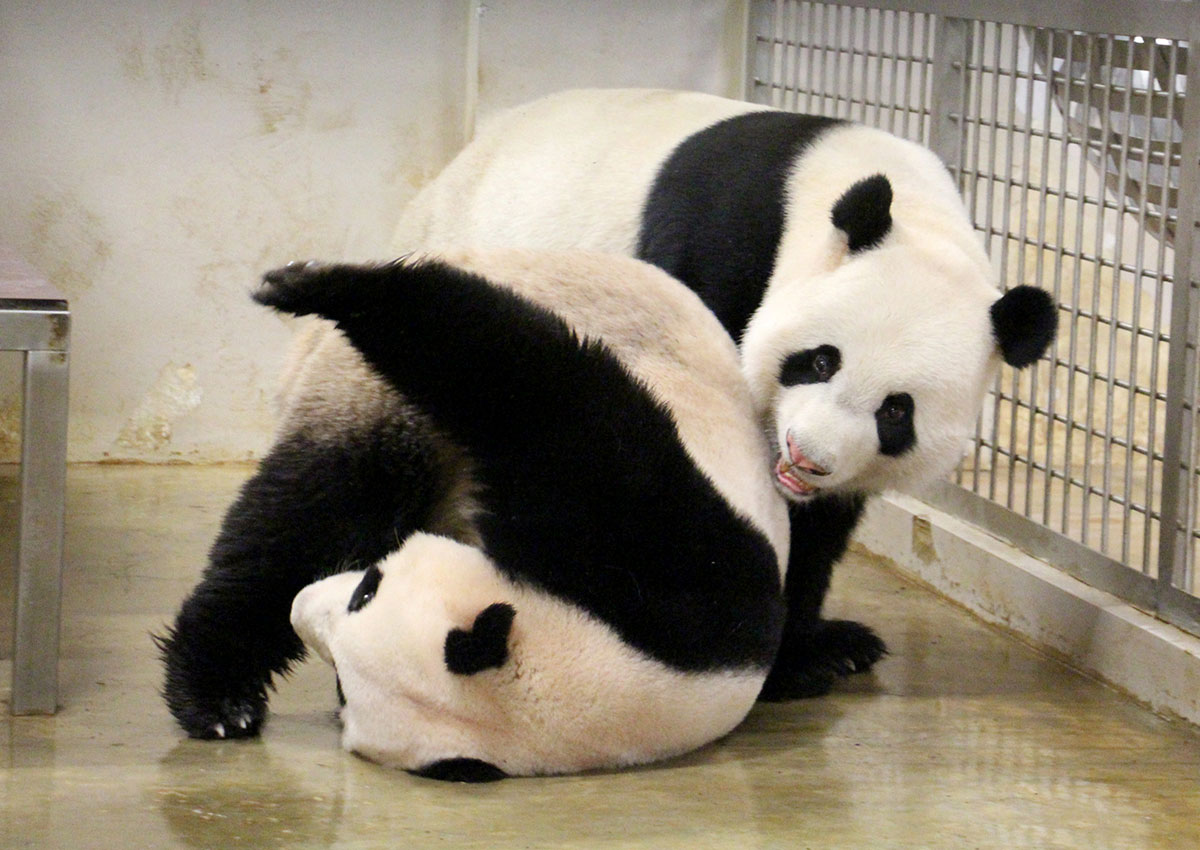There is still no sign of a baby, but vets at the River Safari believe they are becoming more versed in the art of panda love.
And science too.
In the last two years, they have tried to help Kai Kai and Jia Jia out a little through artificial insemination.
The pandas have been together for about four years but are still young and inexperienced when it comes to mating.
So when Jia Jia shows signs of becoming fertile, humans spring into action (see other story).
Though this year’s attempt was again unsuccessful, Dr Cheng Wen-Haur, chief life sciences officer and deputy chief executive officer of Wildlife Reserves Singapore (WRS), believes they now have a better handle on Jia Jia’s behavioural cues and the period she is fertile, which happens once a year.
“Both Kai Kai and Jia Jia have also shown improvements in their mating techniques since their first mating attempt last year,” said Dr Cheng.
While Kai Kai, nine, and Jia Jia, eight, are friendly to each other, the furry duo, on a 10-year loan from China, are still teenagers in panda years. Unsuccessful mating is therefore not uncommon for the young and inexperienced like them.
Experts in China report a 60 to 80 per cent success rate in getting pandas to mate successfully but, outside of China, it is pretty much “hit or miss”, said Dr Cheng.
Part of it is to do with experience and part of it is the fact that the Chinese simply have more pandas to work with.
All that aside, breeding pandas in captivity is a headache in itself.
In the wild, a receptive female panda would have its pick of the most virile bear – an experienced male in its prime.
“Cut back to us, we have got a boy and a girl – no experience whatsoever, and we expect them to go on and do it,” said Dr Cheng.
Trying to anticipate when the female giant panda is most fertile is also a tricky business. It has only one reproductive cycle per year and is receptive to mating for one or two days. It is fertile for just 24 hours.
This means the vets have a one-day window period or less to ensure the best chance of success. Artificial insemination has to be carried out as soon as the oestrogen level drops, after it peaks.
“By the time it has dropped too much, we would have missed the window period,” said Dr Cheng.
And even if the vets score a hit with the insemination, various other factors could stand in the way of a successful pregnancy taking.
“Female pandas have pseudopregnancy, a state in which pregnancy symptoms are shown but the panda is not pregnant. This makes it challenging to detect a genuine pregnancy,” he explained.
Despite the challenges, vets at the River Safari believe they are getting closer to helping the young pandas become proud parents.
For instance, they were better this year at reading Jia Jia’s signs, and so the procedure was carried out closer to when she was fertile, said Dr Serena Oh, assistant director of veterinary services at WRS.
“This year we did it the very day her oestrogen level dropped. Last year, we did it the day after,” said Dr Oh. Vets and keepers will continue to perfect their timing of Jia Jia’s fertile period.
As giant pandas are seasonal breeders, with females coming into heat in the spring, zookeepers will continue to vary daylight hours and the temperature in their space to simulate the passage of the seasons as they would occur in the pandas’ homeland in Sichuan, China.
“If we want it to get brighter earlier, we just turn on the lights early. If we want it to get darker, we just turn it off and we have dark curtains to make it all black,” said Dr Oh.
Latest estimates have put the population of adult giant pandas at 1,864, moving the status of the cuddly, charismatic species from “endangered” to “vulnerable”.
Fertility specialist Liow Swee Lian said artificial insemination is the cheapest and safest procedure for animal breeding in livestock and wildlife conservation.
Other methods of conservation, including animal cloning and in-vitro fertilisation, are costlier.
“Most importantly, we should do our part to conserve the natural habitats for all animals threatened with extinction. It will be a very sad day for us when we can find these animals only in the zoo,” said Dr Liow.
But while conserving natural habitats is important, breeding animals under human care is a good backup.
Dr Cheng said: “Captive breeding is an important component in the conservation of giant pandas. We need to have an assurance colony in case something disastrous happens in nature.”

This article was first published on Sept 30, 2016.
Get a copy of The Straits Times or go to straitstimes.com for more stories.























































